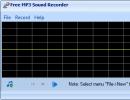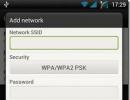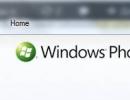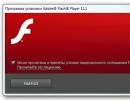How to work with the Paragon program. Paragon NTFS for Mac review: working with the Windows file system on a Mac without problems
Any user who wants to be on friendly terms with their computer cannot do without disk partitioning and data recovery utilities. The list of these programs is quite large, there is plenty to choose from. If you are thinking about purchasing a utility of this class for yourself or your organization, then take a closer look at Paragon Hard Disk Manager from the company (System Utilities), which recently released a new version - 8.5. Among the many other advantages of this version is support for the new Microsoft Vista operating system.
Paragon Hard Disk Manager 8.5 is a program that provides a full cycle of hard drive maintenance:
- loading process management;
- disk partitioning;
- copy and restore operations;
- ensuring system and data security;
- decommissioning the disk.
Paragon Hard Disk Manager 8.5 was released in two editions: and . We received a personal version for testing, and we will talk about its differences from the professional version below.
Hard Disk Manager has a nice, modern interface, which, however, has some minor flaws. In particular, when creating partitions on large disks, the problem of specifying the exact dimensions of the disks arises. The size is set by a slider, which does not allow you to precisely set the required section, and there are no fields for numerical input of the size. This inconvenience is especially noticeable on modern high-capacity hard drives. And the larger the disk in volume, the more difficult it is to get into the required dimensions. Of course, you can then use the partition resizing function and adjust these sizes, but these are unnecessary gestures.
And one more light remark. Changing types of work is implemented in the form of tabs in the main program window. The developers chose “Disk Panel” as the first tab. HDD marking work is important, but one-time. The main thing in Paragon Hard Disk Manager is to perform archiving operations in the current work, as well as restore data from the archive. Switching to a new tab is not a problem, but it would still be better to make the “File Manager” tab first. Or let the program open with the last tab used. Or maybe it's just me being too picky? 
Disk creation is done in a deferred manner. This means that the user can format the hard drive in virtual mode, without making real changes to the HDD. After creating the entire cycle of operations, you can check the correctness of the selected commands, and then click on one single “Apply” button, and the program will begin executing all the specified operations, which are performed quite quickly. After the reboot, all disks will become visible in the system. 
Now archiving. The archiving algorithm is typical: an object to be archived is selected, then a location to store the archive, then process parameters. And the archiving itself is performed. The new version of the personal edition adds the possibility of incremental archiving (that is, copying only those sectors that have been changed since the last copy was received). This significantly increases the speed of the archiving procedure, which is especially important during the daily operation of saving data. 
Over time, any personal user collects a whole package of archives of different dates. (What can we say about corporate use of the program?) Sometimes it can be difficult to figure out what can already be deleted and which copy needs to be kept. For the convenience of users, both editions (personal and professional) have the “Archive Database” function. Also in the new version it is possible to create an extensive text commentary for each of the archives. Now you can, without relying on your memory, record in text form all the necessary notes for each of the archives.
There are also several important innovations in the data recovery mechanism. First of all, it should be noted that it is possible to restore data from an archive capsule without creating rescue disks. As you know, data recovery programs can restore backup copies even if the operating system is “dead.” But to do this, they need to enable booting from CD in the BIOS and have the rescue CD itself.
When using Paragon Hard Disk Manager 8.5 for recovery, you no longer need to change the boot parameters settings, or worry about the safety of the recovery disk. And it’s no longer necessary to have a CD drive itself. Booting the computer and performing any recovery operations in the event of damage to the operating system or other boot problems can be carried out directly from the archive capsule.
Another feature is the Shrink function. In some cases, it is necessary to restore data to partitions that are smaller in size than the original ones, but have enough space to restore the data itself. In this situation, data recovery was previously impossible. But now it can be done without difficulty.
Restoring an entire partition is, in general, also a rare operation, just like disk partitioning. Much more often there is a need to restore some specific, private data, rather than a whole image. For such recovery, the partition archive connection function is used. With this archive connection, all further recovery operations can be performed using the Windows operating system - a simple copy function.
All operations in the program are performed using wizards. Some of them can work in an advanced mode for advanced users. The wizards will help the user correctly and in the right sequence perform operations on working with the disk and working with archives.
Professional version
There are fewer changes in the professional version than in the personal version. Because some of the innovations (in particular, incremental copying) were already present in the professional edition. But here too the developers have something to brag about:
- the "Cyclic Backup" function, which allows you to regularly create backup archives and automatically manage them;
- Hot Backup technology for dynamic volumes.
Summary
Paragon Hard Disk Manager is a convenient and practical tool for working with hard drives and archiving data for users of any skill level. It can store both personal and enterprise data equally well. Particularly valuable innovations in the new version include the ability to restore data without creating a rescue disk, the incremental copy function, and support for the new Windows Vista operating system.
20.12.2015 8587
And it is known that software testing is best done on virtual machines. And although this method has a number of disadvantages, it is much safer. It's simple. Install the operating system on Hyper-V or VirtualBox and do whatever you want with it, and if something goes wrong, as a last resort, you can delete the virtual machine and create a new one.
As for the disadvantages of the method, the main one is the lack of direct access of the virtual machine to some hardware components, and it may also happen that for testing you will need to have exactly the same set of parameters as on the real system. Manually adjusting a virtual system to the base one is a thankless task; it is much easier to convert it into a virtual image, which can then be connected to some virtualization tool.
Can perform such transformation of a real system into a virtual one VMware Workstation, utility Disk2vhd from a famous developer Mark Russinovich, and also a popular program for working with hard drives. We will consider this last tool, or rather the method of converting a physical system disk into a virtual one using it.
To do this we need an activated professional version. So, open the program, in the main window switch to the tab "Copy and Migration" and select tool.


And then check the boxes for those partitions that need to be converted to a virtual image. Chapter "Reserved by the system" must be included without fail.


In the next window you can give the virtual machine a name, select the desired number of cores CPU and volume random access memory.

In the next window we don’t change anything, just click "Further".

Paragon Hard Disk Manager 15 Advanced 17.4.0 – is a program for simple and reliable management of hard drive partitions. Allows you to create, format, delete partitions, make them active, inactive, hide, etc. Supports work with FAT, FAT32, FAT16x, FAT32x, NTFS, Ext2FS, HPFS, Linux Swap partitions. Paragon Partition Manager allows you to resize partitions of all specified types, convert FAT32 to FAT16 without losing data, as well as NTFS to FAT/FAT32 and vice versa; Copying/moving partitions of all types listed above is allowed. Using this program, you can manage the boot process, partition the disk, perform copy and restore operations, ensure the security of the system and data, and decommission the disk. The program is a convenient and practical tool for working with hard drives and archiving data for users of any skill level. It can equally well store data for both a personal user and an enterprise. Supported computer interfaces: Parallel ATA (IDE) HDD; Serial ATA (SATA) HDD; External SATA (eSATA) HDD; SCSI HDD; USB (Universal Serial Bus) 1.x/2.0/3.0; IEEE 1394 (FireWire); RAID support (software and physical); PC or PCMCIA Card (Personal Computer Memory Card International Association). Supported types of hard drives and external media: drives with a capacity of more than 2.2TB; AFD (Advanced Format Drive); any disks with a sector size other than 512B; solid state drives SSD (Solid State Drive); HDD hard drives; CD-R/RW; DVD-R/RW; DVD+R/RW; DVD+/-R (DL); BD-R; BD-RE. Supported file systems: NTFS (v1.2, v3.0, v3.1), FAT16, FAT32, Linux Ext2FS, Linux Ext3FS, Linux Ext4FS, Linux Swap, Apple HFS+, other file systems (in sector-by-sector read and write mode). Supported disk partitioning schemes: MBR (Master Boot Record), GPT (GUID Partition Table), Microsoft dynamic disks (simple, spanned, striped, mirrored, RAID-5). You can download the program via a direct link (from the cloud) at the bottom of the page.Main features of Paragon Hard Disk Manager:
click on the picture and it will enlarge



| System requirements: | |
| Operating system: | Windows 7,8,10 (x86,x64) |
| CPU: | 2 GHz |
| RAM: | 4 GB |
| Hard disk space: | 711 MB |
| Interface language: | English |
| Size: | 116 / 130 MB |
| pharmacy: | cured |
| *archive WITHOUT password |
Even if you exclusively prefer Apple computers, you still have to deal with the Windows ecosystem from time to time. For example, friends or colleagues may give you a flash drive or hard drive formatted in the Windows NTFS file system. You can copy information from these media using standard OS X tools, but writing something to NTFS partitions is a no-no. For some, this problem may not seem significant, but for others, for study or work (for example, printing out an essay or handing over a revised project to a customer), it is important to be able to use NTFS media. Yes, we can say that now everyone has the Internet, and you don’t have to remember about flash drives and disks at all, but situations are different.
For example, according to various sources, up to a third of all Mac owners “keep” Windows on their PCs/laptops as a second operating system. It happens that you need to run some software (or toys) that is not available for OS X. So, the NTFS partition on your disk will be read-only. And if you create a document in Windows, you will no longer be able to edit it from MacOS.
Teaching OS X to fully accept the Windows NTFS file system is not that difficult. For true geeks, there is a way to edit the fstab system file. There is one advantage here - this method is “native”. But, as with any intervention in the “insides” of the OS, it is possible to have unpredictable consequences - up to and including complete system inoperability.
Another option is to use third party drivers. Among them there are both free and paid options. Free ones have two main disadvantages. Firstly, the recording speed is “stool”. Secondly, job stability is in question.
It is much easier to pay for Paragon NTFS for Mac (standard price - 990 rubles, special purchase conditions are discussed in the conclusion). The utility from a well-known software company is quickly updated and works reliably. There are no problems with reading and writing speed - everything is similar to how OS X works with the “native” HFS+ file system. For example, a 10 GB movie can be uploaded to an external hard drive with Windows NTFS using a driver from Paragon Software in a minute. The free option for solving the same problem will take you more than 10 (ten) minutes! The Paragon utility is quickly updated in anticipation of the release of new OS versions, and now works great with El Capitan.
Paragon NTFS for Mac has advanced support for both HFS+ (POSIX file attributes, hard links, symbolic links, data branch points and resource forks) and Windows NTFS (sparse, compressed files/partitions, updating last session information, etc.). ), as well as extended attributes for OS X and non-Latin languages. All types of hard drives, flash drives, and memory cards are supported. Tests were carried out on drives with capacities up to 10 TB. And most importantly: the Paragon NTFS for Mac utility works on a “set it and forget it” basis.
More information about the NTFS for Mac program.
Functional
- performing various operations with disk partitions;
- changing some partition parameters (hiding, showing, deactivating, changing the volume label, assigning or deleting a logical drive letter, converting the file system, etc.);
- redistribution of space between volumes;
- copying partitions and disks;
- creating backup system archives, as well as data from local and network drives;
- restore disks, partitions, cancel the operation in case of an error;
- quick viewing, copying and editing of directories and files using the built-in file manager;
- partition defragmentation;
- optimization of cluster partitions;
- setting up and managing multiple operating systems from one device;
- creating a boot disk on a flash drive.
Advantages and disadvantages
Advantages:
- free distribution;
- convenient, simple interface;
- ability to search for bad disk sectors;
- support for all media models;
- useful feature sets;
- step by step master.
Flaws:
- shortcomings while working with the boot disk;
- limitations of the free version.
Victoria HDD Free program for testing and diagnosing your hard drive. It can detect and eliminate defects in its operation, display complete technical information about it, accurately assess the current state, evaluate performance, etc. It has a built-in file manager.
HDDScan. A free software product created for hard drive diagnostics. It can check it for bad sectors and errors, display S.M.A.R.T, change some parameters, etc.
Defraggler. Disk defragmentation application. Makes it possible to defragment the entire disk, as well as its individual folders or files. Distributed free of charge.
How the program works
After starting the program, the disks are scanned immediately, then its main menu opens:
Interface
The menu consists of a line, an action panel, a structure of hard drives, a panel with an OS reminder, a visual section, and the structure of the specifically selected disk.
The operations menu can be called up by right-clicking the mouse:

Operation menu
If you click on the hard drive icon, a screen will appear to change the name of the label; if you click on its letter, an information window will be activated:

Disk information
Let's look at individual functions, for example, partitioning a disk.
To begin, at the bottom of the program, in the “Disk Map” item, select the disk you need. Next, call up the context menu and click on the “Move/Resize Partition...” option in it:

Disk partitioning
In the next window, specify the final size.

You can also learn about working with the program from the video:
Paragon Partition Manager is one of the best free managers for organizing your hard drive.





